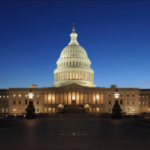The power to make laws in our country falls in the hands of the Legislative Branch. The branch is outlined in Article I of the Constitution. The Legislative Branch is divided into two houses of Congress. The House of Representatives is made up of representatives proportionate to their state’s population while each state maintains equal representation in the Senate. Learn all about Article I in the National Constitution Center’s learning module.
Starter Kit: Checks and Balances Podcast
We exist in a delicate balance. Ours is a system designed to counterweight itself, to stave off the power grabs that entice even the fairest of us all. The U.S. government is comprised of humans, not angels, so each branch has the power to stop the other from going to far. The only catch being, of course, they have to actually exercise that power. In this episode, with the inimitable Kim Wehle as our guide, we learn what those checks actually are, and how the Executive, Legislative and Judicial branches (ostensibly) keep things democratic.
This short episode includes a one-page Graphic Organizer for students to take notes on while listening, as well as discussion questions on the back side.
Congress and the Legislative Branch: Lesson Plans & Resources

This Share My Lesson collection provides free lesson plans and resources to support teachers in educating students about the legislative branch of Congress. Students will learn about the powers of Congress and state legislatures, how those powers have been used or changed over time, and what issues face Congress today.
Congressional Power of Impeachment
In the Constitution, the Congress is given the sole power of impeachment and removing the President and all civil officers from office. This power of Legislative Branch provides a significant check over the Executive and Judicial Branches. This lesson provides explanations of the Constitutional basis of the power, the process for removing officials and the history of impeachments and removing these officials from office. It also provides discussions on the standards of impeachments and how those are interpreted by Congress.
Congress by the Numbers
Together, the U.S. House of Representatives and U.S Senate are called Congress, the legislative branch of the federal government. Congress has many powers including writing the nation’s laws, approving treaties, and declaring war.
Compromise at the Constitutional Convention
This activity is designed to help students understand the debates at the Constitutional Convention in 1787 that shaped America’s legislative branch of government. The primary goal is for students to discover how a compromise balanced the needs of large states and small states and how this led to the
creation of the current House of Representatives and Senate. In contrast to the real convention, this activity is simplified and focused to come to a conclusion in a class period.
The Legislative Process
Nine videos explain each of the common legislative stages, and that the process by which a bill becomes law is rarely predictable.
Congress in a Flash! (Lesson Plan)
Need to teach the legislative branch in a hurry? This lesson is designed to cover the basics in a single class period. Students learn what Congress is, what the Constitution says about the legislative branch, and how a bill becomes law. They analyze some actual language from the Constitution, compare the House and the Senate, and simulate the lawmaking process by reconciling two versions of the same fictional bill. This lesson is one in a series entitled “The Legislative Branch.”
The Powers of the President
In this lesson, students will view video clips to learn about the powers of the president and how they have grown and been used throughout our history. Students will use these video clips to respond to a writing prompt about the balance of powers between the three branches.
The Constitution
This series of videos breaks down the different parts of the United States Constitution for students. In the videos, Kim and Sal interview constitutional scholars associated with the National Constitution Center, including Jeffrey Rosen, Heather Gerken, Ilya Somin, and Richard Garnett.